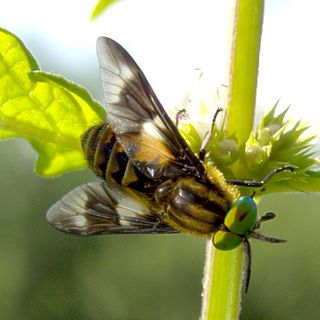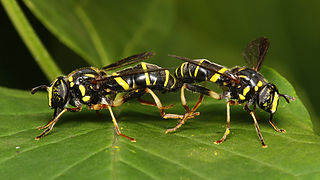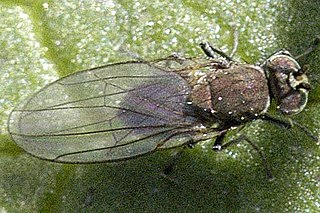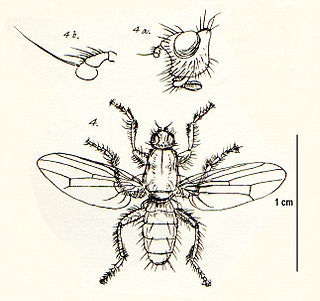
The family Sciomyzidae belongs to the typical flies (Brachycera) of the order Diptera. They are commonly called marsh flies, and in some cases snail-killing flies due to the food of their larvae.

Superfamily Tabanoidea are insects in the order Diptera.

Xylota is a Holarctic genus of hoverflies similar in structure to the related genera Chalcosyrphus and Brachypalpoides. As the larvae are saprophytic they're usually found in rotting wood. The adult flies are generally associated with woodland and woodland edges and can often be seen running over the upper sides of leaves. Unlike other syrphids the adults of many species rarely visit flowers preferring instead to gather pollen from leaf surfaces. There are over 100 described species of which 12 can be found in Europe. Seven species have been recorded in Britain. Identification of species has been difficult and identifiction by photographs is risky.

Ochthera is a genus of flies in the family of shore flies (Ephydridae). The genus is distinctive because of the swollen raptorial forelegs. The larvae are predaceous on midge larvae while the adults feed on midges and mosquitoes. The genus is found around the world with about 37 species. The species Ochthera chalybescens has been shown to prey on African malaria vectors.

Spilomyia is a genus of hoverflies. Many species in the genus show Batesian mimicry of wasp models, including black and yellow patterns and modified antenna shape.

Urophora is a genus of tephritid or fruit flies in the family Tephritidae.

Trupanea is a genus of tephritid or fruit flies in the family Tephritidae.

Pelecorhynchidae is a small family of flies. All of the genera were originally placed in the family Rhagionidae, and their elevation to family rank has been controversial. Other phylogenetic analyses have supported Pelecorhynchidae as a distinct clade from Rhagionidae. The adults of Pelecorhynchus mostly feed on nectar of Leptospermum flowers. Larvae have been collected in the damp margins of swamp areas, where they feed on earthworms.

Zabrachia is a genus of soldier flies in the family Stratiomyidae. Adults can be distinguished from other Pachygastrinae by the fused R4 and R5 wing veins. Females have been collected during oviposition into pine wood, and larvae are known to live under the bark of coniferous trees, including lodgepole pine, ponderosa pine, and Douglas fir.

Nostima is a genus of shore flies in the family Ephydridae.

Hydrelliinae is a subfamily of shore flies in the family Ephydridae.
Stonemyia californica is a species of fly in the family Tabanidae.
Hyadina is a genus of shore flies in the family Ephydridae.
Pseudoerinna jonesi is a species of fly in the family Pelecorhynchidae.

Coelopa is a genus of kelp flies in the family Coelopidae. There are about 14 described species in Coelopa.

Sciomyzini is a tribe of flies in the family Sciomyzidae.

Sciomyzinae is a subfamily of flies in the family Sciomyzidae.
Cephalosphaera is a genus of flies belonging to the family Pipunculidae.












